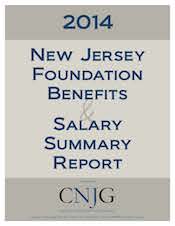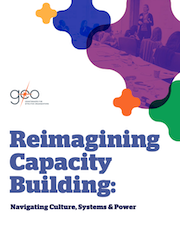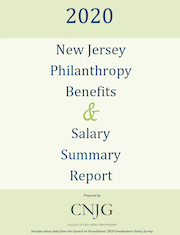Site Search
- resource provided by the Forum Network Knowledgebase.
Search Tip: Search with " " to find exact matches.
Nonprofit Finance Fund's Annual Survey chronicles the challenges facing the nonprofit sector and calls out some of the targeted investments we can start to agree on as a society to salvage the investment we have collectively made in our social infrastructure. We believe that a coordinated intervention now will not only better prepare us for inevitable future economic crises; it can lead to a happier, healthier community for us all.


The 2014 New Jersey Foundation Benefits & Salary Report provides a valuable benchmarking resource, developed and compiled for exclusively for CNJG members. The first section, the 2014 Benefits Summary Report: New Jersey includes benefits data related to employment, leave, retirement, costs and more. The second section, the 2014 Grantmaking Salary Tables: New Jersey, Tri-State Area and National Data provides compensation across a wide range of positions and grantmaking entities, and includes salary data from the Council on Foundations’ 2014 Grantmakers Salary Survey.
Novartis benchmarked Employee Crisis Programs, and asked fellow corporate funders via the corporate funders listserve to answer the questions below.
- If you have an Employee Crisis Program, what is the name
- Do you manage the program internally or thru a 3rd party? If you use a 3rd party, can you share their name/website and any good/bad experiences.
- Do you only support disasters or other hardships as well?
- What is the average percentage of your employees that apply for aid?
- What is your minimum and maximum funding?
- What is the average amount of aid?
- Do you provide aid directly to the employee and/or vendors?
- Do you allow employees to donate to your fund? If so, how do you promote awareness and what is the employee donation participation rate? Do you match these donations?
- Where does the program reside (CSR, Foundation, HR)?
- Please share guidelines and applications, if possible.
- Please share any other insights.


The 2020 New Jersey Philanthropy Benefits & Salary Report provides a valuable benchmarking resource. Developed and compiled for CNJG members exclusively, the report presents comprehensive benefits data specific to New Jersey's grantmaking community, alongside data from the Council on Foundations' annual salary survey. Produced every three years, this benchmarking report is a highly valued benefit of your membership in the Council of New Jersey Grantmakers. Thank you to the CNJG members that completed the benefits survey earlier this year that enabled us to produce this report.
The first section, 2020 Benefits Summary Report, includes benefits data for the 2020 calendar year and covers employment, leave benefits, insurance benefits, and more. We are delighted to also present for the first time in this triennial report, demographic data on the boards and staffs of those that responded. The second section, 2020 Grantmaker Salary Tables: New Jersey, Mid-Atlantic and National Data provides data on compensation across a wide range of positions and grantmaking entities. Thank you to the CNJG members that completed the Council on Foundations’ annual survey on salaries that enabled us to produce this section of the report.
Sample conflict of interest policies for Community Foundations.
